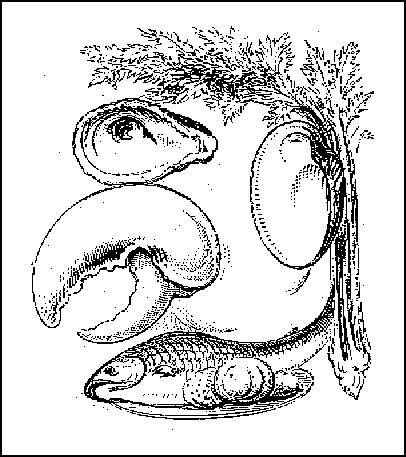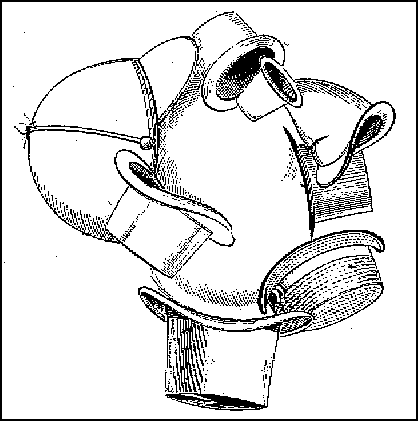How to Analyze Slops
 That first year of the Garbage Project was one of discoveries large and small. That garbage itself was an unknown world --- everything learned about it was new --- and thus held the fascination that a trip up the Congo in the nineteenth century would have.
That first year of the Garbage Project was one of discoveries large and small. That garbage itself was an unknown world --- everything learned about it was new --- and thus held the fascination that a trip up the Congo in the nineteenth century would have.Another phenomenon that quickly became clear was the capacity of garbage to surprise. This was vividly brought home to researchers as a result of the discovery, by an anthropology student named Diane Tucker, of a diamond ring amid a mass of potato peels. (The ring, a relatively inexpensive one, could not be returned, because of Garbage Project procedures to ensure that the identity of the house-holds from which garbage for study is obtained remains unknown; it was accidentally thrown away along with other prospective exhibits for a Garbage Project museum, all of which had been stored in a special dumpster.)
Most of the surprises, however, have not been so immediately obvious. They have not, in other words, tended to be the garbage equivalent of finding the Mask of Agamemnon or the cave paintings at Lascaux. Rather, they have emerged through the careful recording of each and every artifact found in each and every load of garbage, and the statistical evaluation of the results.
A good example that comes from the Garbage Project's first two seasons, involves red meat. The counterintuitive nature of the findings are typical of what garbology frequently turns up. During the spring of 1973 there had been a widely publicized beef shortage in the United States. From March through September a good selection of beef in supermarkets was hard to find, and the meat was very expensive. The Garbage Project, which from the beginning has been very interested in food waste, decided to look into discard patterns of red meat to see if people's behavior changed appreciably between times of shortage and (afterwards) times of plenty.
As it happens, meat is an ideal subject for investigation, because supermarket meat-counter packages are labeled with the type of cut, the weight, the price, and the date of packaging (which is usually on or very near the date of sale); it is thus possible to compare the amount of wasted meat thrown away in garbage with the amount of meat that was originally bought.
 Garbage data on beef were collected over a period of fifteen months, from the spring of 1973 through the spring of 1974, and the numbers, when analyzed, revealed a strange pattern. In the months after the beef shortage ended, the rate of beef waste (cooked and uncooked, but not counting fat or bone) amounted to about 3 percent of all the beef bought. During the months of the shortage, in contrast, the rate of waste was 9 percent. In other words, people wasted three times more beef when it was in short supply than they did when it was plentiful.
Garbage data on beef were collected over a period of fifteen months, from the spring of 1973 through the spring of 1974, and the numbers, when analyzed, revealed a strange pattern. In the months after the beef shortage ended, the rate of beef waste (cooked and uncooked, but not counting fat or bone) amounted to about 3 percent of all the beef bought. During the months of the shortage, in contrast, the rate of waste was 9 percent. In other words, people wasted three times more beef when it was in short supply than they did when it was plentiful.
This conclusion seemed perverse, but the data, when checked, seemed solid. Eventually a Hypothesis was put forward to account for the odd behavior: the practice of crisis-buying. When confronted with the widespread and sometimes alarmist coverage of the beef shortage in the local and national media many people may have responded by buying up all the beef they could get their hands on, even if some of the cuts were unfamiliar. Of course, they didn't necessarily know how to cook some of those cuts in an appetizing way. More important, they didn't necessarily know how to store large amounts of meat for an extended period of time. The inevitable result in either case: greater waste.
This hypothesis was buttressed by the discovery in some Tucson garbage samples, during the shortage months, of a few whole cuts of beef, which it is very likely had spoiled prior to being discarded.
The general proposition drawn from the findings about red meat --- that wastage of a food increases when that food is scarce --- was unexpected, but in the context it seemed reasonable. The reaction among nutrition educators and home economists when this result was reported, however, was somewhat muted, their criticism being that the hypothesis was probably not broadly applicable to a wide range of foods.
Fate smiled on the Garbage Project in the spring of 1975 by unleashing a sugar shortage. As the price of sugar and high-sugar products doubled, the wastage of those items in Tucson's garbage tripled. Because Tucson is only sixty miles from the U.S. border with Mexico, where the price of sugar had remained stable, many Tucsonans stocked up with sugar that they bought south of the border. Mexican sugar, however, is not as highly processed as American sugar; it is browner, and it turns hard quickly. Before long, hard, brown bricks of Mexican sugar began appearing in the garbage. Some Tucsonans began buying Desserta and other unfamiliar products made from sugar substitutes, such as cyclamates; the reviews were plainly evident in the form of unconsumed discards.
Also prominent in the trash were items containing sugar that had crystallized during the course of long-term hoarding. In sum, the behavior of people in the midst of the sugar shortage corroborated the findings about red meat. The sugar shortage, more sharply than the beef shortage, also drew attention to the role that unfamiliarity with a food plays in the wasting of that food.
From the information garnered during the beef and sugar shortages the Garbage Project developed the First Principle of Food Waste: The more repetitive your diet --- the more you eat the same things day after day --- the less food you waste. In hindsight the First Principle seems simple and obvious. The waste in garbage from the standard sixteen-ounce and twenty-four-ounce loaves of sliced bread that every household buys regularly is virtually nonexistent --- at most, crusts and ends; this is because common sandwich bread is used continually, meal after meal.
But specialty breads --- hot dog buns, bagels, muffins, biscuits, kaiser rolls --- are wasted at rates of 30 to 60 percent, because they are bought less regularly and perhaps used once or twice in very specific kinds of meals before finding a place in the bread box or the back of the refrigerator to harden or decay.
The First Principle helps to explain why the garbage collected from Mexican-American census tracts generally has less food waste --- sometimes, more than 20 percent less --- than does garbage from Anglo census tracts. Mexican-American border cuisine offers a diverse array of dishes, but the ingredients are few: tortillas; beans; chunks of beef, chicken, and pork; avocados, tomatoes, lettuce, onions; red and green chili sauce; salsa. Not only is it easy to incorporate leftovers into new meals, but the staple ingredients are in a state of constant turnover.
No one is very happy about the First Principle. Nutritionists are always trying to get people to broaden their dietary horizons. Producers and marketers of food and other goods make a significant part of their living by providing novelty and diversity, and those very qualities are, as it happens, deeply appreciated by consumers.
Still, gaining insight into certain basic elements of the architecture of behavior can have positive practical consequences --- in this case, with respect to the reduction of food waste. Garbage Project studies indicate that American families waste between 10 and 15 percent of the food they buy. In the history of the Project, of all the bags of household garbage that have been examined, only a handful have been found to be innocent of wasted food.
The Archeology of Garbage
William Rathje and Cullen Murphy
©2001 (University of Arizona Press)